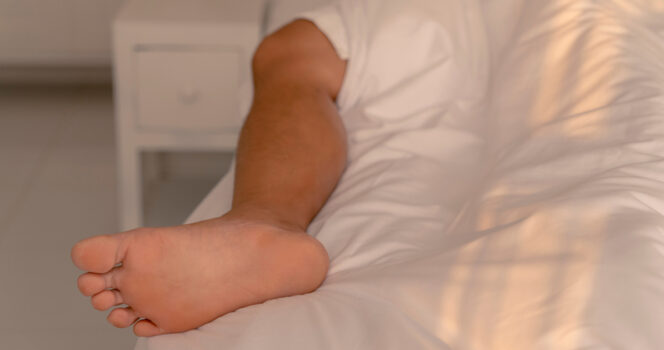
You’ve probably done it without even thinking – kicked one foot out from under the blanket to cool down at night. But this common sleep habit isn’t just a quirky comfort move. According to science, it may be one of the simplest and most effective ways to help your body transition into sleep more easily and quickly.
So, what makes the dangling foot trick work so well? It turns out, the answer lies in how your body naturally handles temperature before sleep – and how your feet are uniquely designed to help regulate it.
Heat, feet and sleep
As evening falls, your body begins preparing for rest by lowering your core temperature, a natural part of the circadian rhythm. Experts say that this internal cooling is essential for initiating deep, restful sleep.
“The drop in temperature starts about two hours before you go to sleep, coinciding with the release of the sleep hormone melatonin,” writes the Sleep Foundation. “During sleep, body temperature continues to fall, reaching a low point in the early morning and then gradually warming up as the morning progresses.”
During this cooling process, your body directs warm blood away from the core and toward the surface – particularly your hands and feet. When these extremities are exposed to cooler air, they act as natural heat vents, releasing excess warmth to speed up your body’s transition into sleep mode.
Perfect heat-release tools
Unlike most other parts of your body, your feet (and hands) are rich in specialized blood vessels called arteriovenous anastomoses, which allow heat to escape quickly. These vessels bypass capillaries and send warm blood straight to the surface, making your soles highly efficient at cooling you down.
By sticking just one foot out from under the covers, you create a passive, adjustable cooling system. It’s like cracking a window in a warm room – small, subtle, and incredibly effective.

“I think it’s likely in service of trying to cool our bodies down because we’ve gotten too warm to sleep,” Natalie Dautovitch, a sleep health researcher and professor at Virginia Commonwealth University, told New York Magazine. “Sticking your toe out or your foot out could bring you to a more restorative sleep.”
Fall asleep faster
Researchers also use a measurement called the distal-to-proximal gradient (DPG), which compares the temperature of your extremities (hands and feet) to your core. A higher DPG means more heat is being released, and it’s closely linked to faster sleep onset.
A study in Journal of Physiology found that people with warmer hands and feet – therefore a higher DPG – fell asleep significantly faster than those with cooler extremities.
Exposing one foot can boost this gradient instantly, helping you fall asleep without needing to strip off all your bedding or crank down the thermostat.
Other ways to support natural cooling
- Letting one foot breathe is simple and effective, but pairing it with other cooling-friendly habits can make your bedtime routine even more powerful:
- Take a warm bath about one to two hours before bed to raise skin temperature and trigger cooling later as you dry off.
- For optimal sleep, keep your bedroom cool, ideally between 65 F to 68 F, as recommended by the Sleep Foundation.
- Warm your feet before bed if you tend to run cold – using socks or a foot bath – then remove layers if needed to fine-tune comfort.
Dangling foot doesn’t work for everyone
While many people find the foot-out method helpful, it’s not one-size-fits-all. If you tend to have cold feet, suffer from poor circulation, or experience conditions like Raynaud’s disease, exposing your foot might feel uncomfortable. In those cases, gently warming the feet before sleep may work better than cooling them.
Children, older adults, and those sleeping in already cool environments may also benefit more from heat conservation than heat release. The key is to adjust based on how your body feels – and remember that comfort, not perfection, is the goal.
The next time you’re tossing and turning under the blankets, try slipping one foot out. This small action taps into your body’s natural thermoregulation system, allowing heat to escape and gently nudging your brain toward sleep.
Sometimes, better sleep really does start from the ground up!
READ MORE
- Why you should always keep your AC low while sleeping
- Why using a fan at night can disrupt your sleep




